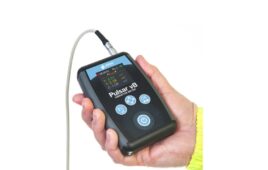In addition to radar, LiDAR and camera sensing used in 3D obstacle detection and collision avoidance in advanced driver assistance systems (ADAS) in vehicles, ultrasonic sensing has been used as well. Traditionally, the ultrasonic sensors used transducer-based technology to provide a microphone to transmit and receive the ultrasonic signal in passenger vehicle parking applications. Using Infineon’s XENSIV™ IM73A135V01 microelectromechanical systems (MEMS) microphone and Toposens proprietary 3D ultrasound technology, Toposens next-generation ECHO ONE DK ultrasonic sensor targets automated guided vehicle (AGV), robot or other applications to avoid collisions with many different types of obstacles. Toposens created its system using real-time 3D data mapping and object recognition software to guide autonomous systems in the most difficult environments.
Low cost and energy efficient compared to existing industrial 3D sensors, the IM73A135V01 MEMS microphone’s superior performance and small form factor enable better ultrasonic 3D sensor systems resulting in the best range and widest opening angle. The performance results from the combination of exceptionally low noise and the highest signal-to-noise ratio (SNR) in the industry, resulting in improved reliability of the 3D data. This allows the detection of very faint ultrasonic echoes from distant, complex and small objects.
In the obstacle detection application, unlike existing sensor technologies where lighting conditions, reflections and weather typically affect their performance, Toposens sensors rely on echolocation to generate real-time 3D point clouds. With an operating range from 200 mm, frame rate of approximately 20 Hz and opening angle of up to 180°, the ECHO ONE DK can guide autonomous systems in very challenging conditions. Echolocation that enables the 3D multi-object detection critical for collision avoidance is achieved with low calibration effort and high reliability and robustness. In addition, the ultrasonic sensing system reduces the high number of false positives and false negatives that can occur with optical sensors that decreases the efficiency of the system.
Filed Under: Sensor Tips





